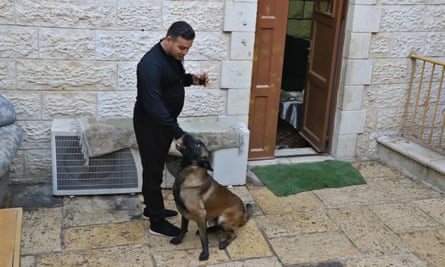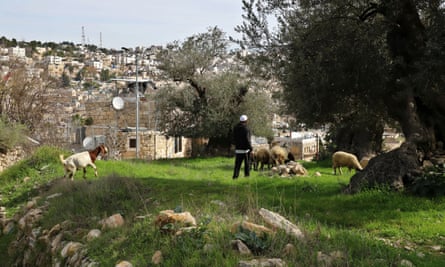Shaadi Muqtasen worries most about his children, who are going crazy with boredom after nearly four months stuck at home without school; and his dogs, which are going wild with frustration after more than 100 days caged in a tiny yard.
His family live in the centre of old Hebron, one of the most heavily contested, heavily militarised places in the West Bank. For Palestinian residents there, life all but stopped when Hamas attacked Israel on 7 October.
Israeli security forces who control Muqtasen’s area, and have a guard post across the street, imposed an immediate lockdown, that in effect constituted house arrest, even for children.
“For the first month, we weren’t allowed to leave the house at all,” he said. “If we even started to open the small grille on the door [to look out], we could hear them cocking their guns.”
Rubbish piled up in their courtyard because they were not allowed to open the door to put it out for collection. He was allowed out once in a month, for an hour, to get food for his family. With so little time, he just bought bags of wheat, “like I was feeding animals”.

Restrictions then eased slightly, and residents were allowed to leave home three days a week. Now they can go out every day, but an unofficial overnight curfew that starts at 7pm is still in place. Schools remain closed, along with most local shops. One barber who attempted to reopen was beaten.
Palestinians living in the centre of Hebron are used to violence and a web of controls that dates back more than 20 years, including bans on walking down some streets that are open to Israelis. The current restrictions, however, are unprecedented, they say.
“Our life was difficult here, but never this difficult,” Muqtasen said. There was a curfew of sorts during the second intifada, when he remembers relatives sending food to their house through a human chain over the roofs of the tightly packed old quarter.
This time is undoubtedly worse, he said. “They are putting very tough conditions to make us leave, so they can have this for themselves. It’s not about security.”
Other residents of “H2”, the part of Hebron controlled by Israeli forces – stationed there to protect about 800 Israeli settlers living among 34,000 Palestinians – say they have been confined to their homes, harassed and attacked since 7 October.
Unharvested olives hang heavy on the terraces of ancient trees that ring the city and the ground is dotted with small, pale green irises, but the only people enjoying the scenery are a settler herding sheep and a group of Israeli soldiers on a tour.

“Now settlers are the masters here,” said Issa Amro, a Hebron peace activist who was detained, beaten and tortured on 7 October. He no longer has a full range of movement in one hand and says doctors have told him the damage he sustained may be permanent. “I am well known, and look what they did to me. The others are afraid.”
Like Palestinian neighbours and Israeli activists, Amro says settlers are exploiting Hamas’ slaughter to try to consolidate their position, hoping to drive Palestinian civilians out of Hebron under the pretext of fighting terror.
“I was not beaten and tortured because I am a member of Hamas. They know my politics; they know I am not religious,” he said. “They are using the tragedy, the blood of Israelis and Palestinians, to fulfil their dream of ‘the river to the sea’ [the Jordan to the Mediterranean] without Palestinians. What they are doing has no relation to security.”
Hebron is the most important economic hub for the Palestinian Authority, the second largest city in the West Bank, and for deeply entwined religious and political reasons, a nexus of conflict.
It is dominated by a 2,000-year-old compound built by King Herod to mark caves that Jews, Christians and Muslims believe hold the remains of the patriarch Abraham and his family.
Sacred to all the Abrahamic religions , which take their collective name from the biblical figure enshrined there, it draws the devout and the fanatical, and has been the site of some of the worst intercommunal violence of the last century.

In 1929, Arab mobs murdered 67 Jews in Hebron, forcing others to flee. Sixty-five years later, the Jewish extremist Baruch Goldstein killed 29 Muslim worshippers in the mosque above the tombs.
One of Hamas’s most important West Bank strongholds, it is also a crucible of Israel’s far-right settler movement, which was launched there and now props up Benjamin Netanyahu’s coalition. His national security minister, Itamar Ben-Gvir, lives in Hebron, and his first date with his wife was reportedly at Goldstein’s tomb in a settlement there.
Hebron was partitioned under the Oslo Accords into H1, an area under Palestinian Authority control where the majority of Hebron’s 230,000 residents live, and H2, under Israeli control.
It is here that systems of separation, which internal and external critics describe as de facto apartheid, are the most extreme and visible in the West Bank.
The military map of the town centre is a complicated web of colours. Red streets, where passage has been denied to Palestinians for more than 20 years, are “sterile”. Palestinians can walk on orange streets, but not drive or undertake any commercial activity.
The Israeli military say these security controls are necessary for the protection of Israelis and Palestinians alike.
Settlers are open about their desire to expand their foothold in Hebron. Critics say they were empowered by the state to pursue this agenda after 7 October when they effectively became the army, called up as reservists to Hebron-based military units after regular troops were sent to Gaza.
The government has also handed out military-grade weapons to civilians and the settlers’ own security forces, who can be seen on the streets of Hebron in a mismatch of uniform, partial uniform or civilian clothes that make it impossible to identify their command structure.
Communities are now at the mercy of ill-defined armed groups that look and act more like paramilitary factions than tools of state power, said Nadav Weiman, deputy director at Breaking the Silence, an NGO that documents Israeli military abuses in occupied areas.
“Since 7 October, Palestinians don’t know if they are dealing with settlers or the army. The settlers are the army, and the army is made up of settlers,” he said. “They are raiding homes, stopping cars, even stealing, in the army of the IDF.”

“If this were the Balkans in the 1990s, I would say they were paramilitaries. But they are the Israeli military. There used to be a facade of maintaining rule of law in Hebron. It was military law, but Palestinians could challenge it, appeal. What is happening now just feels like revenge.”
The confusing mix was on display at the entrance to the Hebron settlement of Kiryat Arba, when three people with assault rifles manning a checkpoint verbally abused an Israeli human rights activist and two journalists.
One man was in civilian clothes, a woman wore the uniform of the settlement security force, and a second man was wearing part of a reservist uniform.
Together, this mixture of security forces has locked down Palestinians living in Israeli-controlled Hebron with violent intimidation rather than written orders.
“There are no papers [to justify searches, detentions and closures]. That’s why I say it is like a militia,” Amro said. “They know what they are doing; they are making the lives of Palestinians harder and harder to force them to leave.”
Israeli forces controlling parts of Hebron have not only confined Palestinian residents to their homes, but have also barred any other Palestinians from crossing checkpoints controlling access, locals say. That means no family visits to celebrate or grieve, no doctors or medical professionals, no tradespeople for repairs, and no teachers – though schools are closed anyway.
“One woman miscarried on 14 October. From 5am to midday, no ambulance was allowed to come in and she was not allowed to leave,” said Amro, who has strained his back carrying cooking gas and other supplies from the nearest checkpoint.
The IDF said in a statement that Hebron was not under curfew. It said traffic restrictions were “imposed in accordance with the situational assessment and operational considerations … and with the intention of reducing harm to [the population] as much as possible”, that requests to pass through checkpoints were “examined according to the relevant criteria”, and that it had not instructed schools to close.
It described the claims about the woman who miscarried as “absolutely baseless”.
In four hours walking and driving around the centre of Hebron, the Guardian did not see a single Palestinian outside their home. The only people on its ghostly streets were soldiers and young boys on bikes, recognisable as settlers from their yarmulkes.
“I’ve never seen kids stuck in their homes this long,” Amro said. “Now there are no kids in the street. People are so intimidated.”
